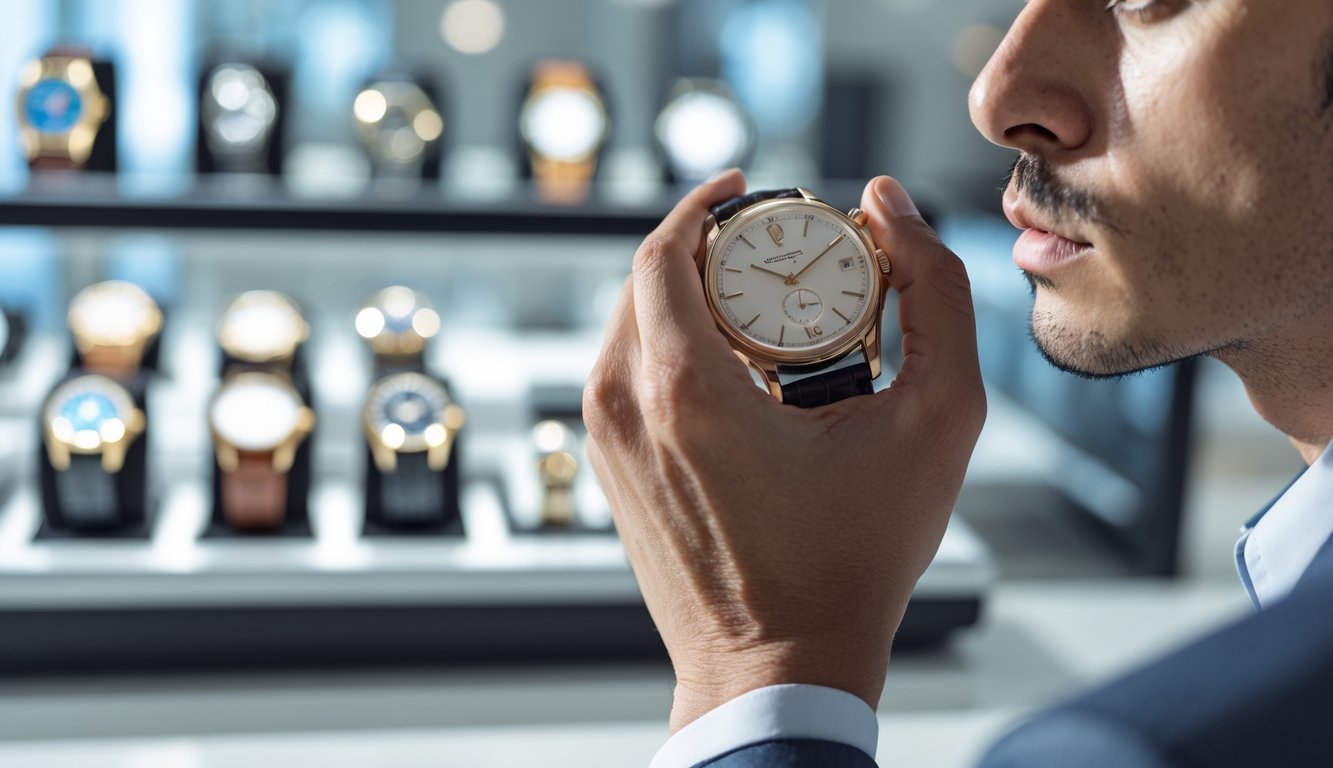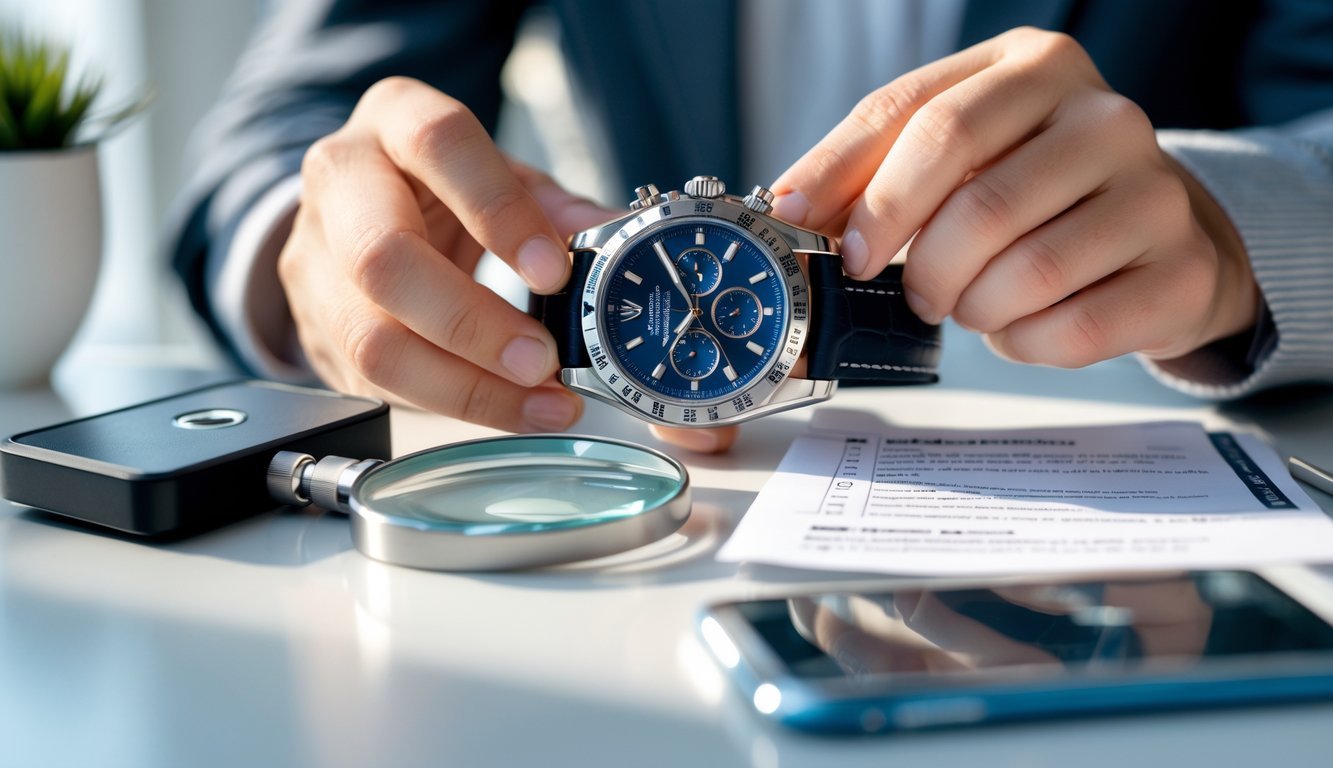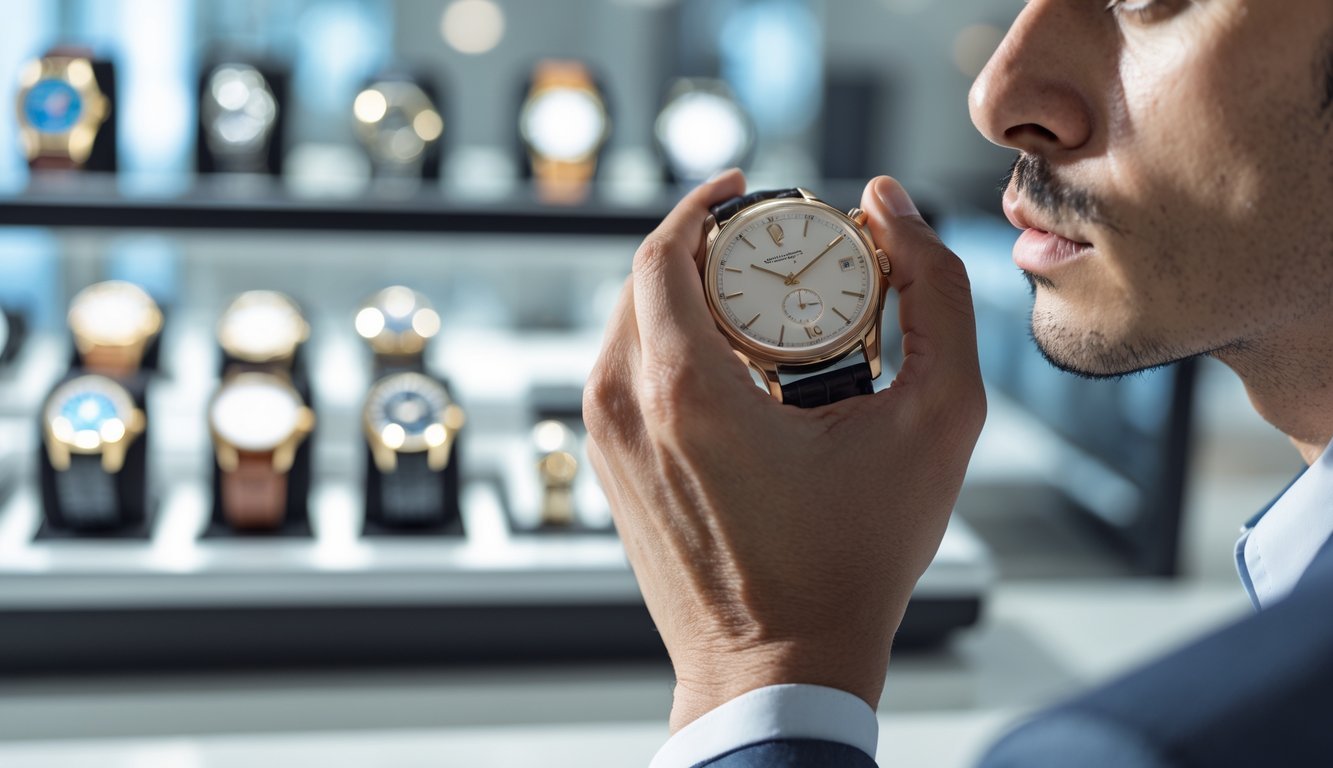Buying a watch from an unreliable seller can quickly drain your wallet.
You might lose hundreds or even thousands on fakes, bad service, or scams.
To protect yourself, you need to spot warning signs early and know how to act if things go sideways. Whether you’re hunting for stylish and reliable men’s watches or just browsing deals online, unreliable sellers are everywhere.

Maybe you think you’ve finally found a great deal on that luxury watch you’ve been eyeing.
But if you don’t know what to look for, you could wind up with a fake that falls apart in weeks.
Some sellers will just take your money and vanish.
It’s a risk that’s all too real.
Smart buyers do their homework on sellers before buying.
They know what red flags to look out for during the purchase.
This guide gives you practical ways to spot sketchy sellers and what to do if something goes wrong.
Key Takeaways
- Look for warning signs like prices that seem too good, sketchy communication, and missing paperwork before you buy
- Always check seller credentials, read reviews, and stick to safe payment methods
- Know your rights and have a plan for returns, disputes, and getting help if things go sideways
Identifying Signs of Unreliable Watch Sellers

Bad sellers usually give themselves away with their listings and behavior.
Watch out for listings with vague info, missing details about the watch’s condition, or sellers who dodge questions about authenticity or returns.
Common Red Flags in Watch Listings
Low-quality photos are a big warning sign.
Trustworthy sellers post clear, well-lit pics from different angles.
If you see blurry, dark, or overly filtered photos, that’s a red flag.
Vague descriptions without specific details are another issue.
Good sellers list model numbers, case sizes, and movement types.
They’ll say if a dive watch has a quartz or automatic movement.
Missing info about key features should make you pause:
- No mention of case material like stainless steel
- No details about the bezel’s function
- No water resistance rating, especially for sports watches
- No serial numbers or authentication papers
If a luxury watch is way cheaper than normal, ask yourself why.
Honest sellers set fair prices based on condition and market value.
Be careful with sellers who try to rush you.
Stuff like “limited time offer” or “buy now before it’s gone” is usually just pressure tactics.
Evaluating Seller Reputation and Customer Feedback
Check the seller’s feedback and read recent reviews.
Look for patterns, especially complaints about fake watches or bad communication.
Don’t just look at star ratings—read what buyers actually say.
People will mention if they got watches that didn’t match the description or had trouble with returns.
Pay attention to things like:
- How quickly the seller replies to messages
- How many watches they’ve sold
- Detailed feedback from recent buyers
- Whether they communicate professionally
New sellers with no feedback aren’t always shady, but there’s more risk.
Ask them extra questions about the watch’s history and their return policy.
If a seller has mostly good feedback but suddenly gets negative reviews about authenticity, that’s a red flag.
They might have started selling fakes.
Spotting Misleading Claims About Watch Features
Some sellers exaggerate or lie about watch specs to make a sale.
Always double-check claims about movement type, especially with dive watches that need reliable mechanisms.
If a seller calls a quartz movement “automatic” or can’t explain basic features like a rotating bezel, that’s a bad sign.
You’ll often see misleading claims like:
- “Swiss-made” without proof
- Water resistance ratings that seem too high
- Wrong info about case materials
- Fake vintage or “limited edition” status
If a seller refuses to share close-up pics of the movement or case back, be skeptical.
Real watches have markings and serial numbers that honest sellers show off.
Question vague descriptions like “excellent” or “like new” if they don’t mention scratches or wear.
Good sellers are upfront about flaws.
Best Practices for Dealing With Unreliable Watch Sellers

Protecting yourself from unreliable sellers takes some effort.
You’ll need to check authenticity, ask for details, stick with safe payment methods, and understand all the policies before you buy.
These steps really help you avoid fakes and make sure you get what you paid for.
Verifying Watch Authenticity Before Purchase
Ask for high-res photos of the watch face, case back, and movement.
Look for clear engravings, real serial numbers, and fonts that match the brand’s style.
Check their reputation on multiple review sites.
Trustworthy sellers have good feedback over several years.
Ask for original papers, certificates, or service records.
Real watches usually come with paperwork from authorized dealers.
Red flags include:
- Blurry or stock photos
- Prices way below normal
- Sellers who won’t send more photos
- Missing serial numbers or weird engravings
Ask for a video of the watch running.
You’ll want to see the movement in action—the second hand should move smoothly if it’s mechanical.
Asking the Right Questions About Watch Specifications
Ask about the exact quartz movement type or mechanical caliber number.
Good sellers know these details and will answer confidently.
Check the water resistance rating and ask if it’s been tested lately.
A lot of sellers claim dive watches are swim-ready when the seals might not be.
Ask about:
- Case material and size
- Crystal type (sapphire, mineral, or acrylic)
- Bracelet or strap condition
- Recent service history
Don’t trust water resistance ratings blindly.
A watch marked for 30 meters usually just handles a splash, not a swim.
Double-check the production year and ask about any changes made to the watch.
Mods can kill value and authenticity.
Securing Safe Transactions and Payment Options
Stick to payment methods that protect buyers, like PayPal Goods and Services or credit cards.
Skip wire transfers, crypto, or cash—those are risky.
For pricey watches, use an escrow service that holds your money until you get and check the watch.
Good payment options:
- PayPal Goods and Services
- Credit cards with chargeback
- Bank transfers with buyer protection
- Escrow services for big buys
Don’t pay the full amount upfront for custom orders or watches that aren’t in stock.
Honest sellers are fine with reasonable payment plans.
If you’re buying locally, meet at a bank or jewelry store.
These places usually have cameras and staff around.
Understanding Return, Warranty, and Water Resistance Policies
Read return policies before you buy.
Trustworthy sellers offer at least a few days for you to check out the watch.
Know the difference between a manufacturer’s warranty and a seller’s guarantee.
Authorized dealers give you full support, while gray market sellers might only cover certain issues.
Ask about:
- Return window length
- Who pays for return shipping
- What’s considered acceptable condition for returns
- Whether the warranty transfers
Ask how they test water resistance.
Some sellers check seals before shipping, others just sell watches “as-is” for water resistance.
Keep all your conversations and policies in writing.
Screenshots can save you if there’s a dispute later.
Frequently Asked Questions

Watch buyers run into all kinds of issues with unreliable sellers, from checking authenticity to staying safe during transactions.
Here are some common questions and practical steps you can take.
What steps should I take to verify the authenticity of a watch before purchasing from a seller?
Ask for clear photos of the watch face, case back, movement, and serial numbers.
Compare these with official brand images or those from authorized dealers.
Request the serial number and check it with the manufacturer.
Many luxury brands offer online tools or customer service for this.
Check the seller’s paperwork.
Authentic watches come with original papers, warranty cards, and certificates that match the serial number.
If you’re spending over $1,000, it’s worth getting a pro appraiser or taking the watch to an authorized dealer.
Look for signs of quality like a smooth second hand, solid weight, and sharp engravings.
Fakes usually have jerky movements and rough finishing.
What recourse do I have if a watch seller misrepresents the condition or authenticity of a watch?
If you paid by credit card or PayPal, contact them right away.
They both offer buyer protection and can reverse charges for scams.
Report the problem to the site where you bought the watch.
Places like eBay have systems for resolving these disputes.
Keep photos, screenshots of the listing, and all your messages with the seller.
You’ll need this as proof.
If you think you’ve been scammed, report the seller to the authorities.
In the US, the Federal Trade Commission deals with online fraud.
If nothing else works and you lost a lot of money, consider small claims court.
Keep all your documentation for your case.
How can I safely conduct transactions with watch sellers to protect against fraud?
Use secure payment methods like PayPal or credit cards—they protect buyers.
Don’t use wire transfers, crypto, or cash for online deals.
For in-person deals, meet somewhere public like a bank or jewelry store.
These places have cameras and staff.
Check the seller’s identity in a few ways.
Look at their social media, business registration, and reviews from other buyers.
Get the return policy in writing before you pay.
Honest sellers usually offer a fair return window for expensive watches.
For big-money deals, try an escrow service.
They hold the money until you get and approve the watch.
What are the red flags to look out for when buying a watch from a new seller?
If the price is way below market value, something’s probably off.
Always check current prices before making an offer.
Sellers who won’t send more photos or give details about the watch’s history should make you pause.
Good sellers answer questions.
Listings full of bad grammar, spelling mistakes, or vague info usually mean trouble.
Trustworthy sellers write clear, accurate descriptions.
If a seller pushes you to close the deal fast without giving you time to check things out, walk away.
Honest sellers let you take your time.
Requests for odd payment methods like wire transfers or crypto should make you nervous.
The pros stick to standard payment options.
How should I approach getting a watch appraised to ensure I’m paying a fair price?
Find a certified appraiser through groups like the American Society of Appraisers.
These folks have the right training.
For expensive watches, get opinions from two different experts.
It helps you get a more accurate value.
Make sure the appraiser focuses on watches, not just general jewelry.
Watch specialists know the details that matter.
Ask for a written appraisal with descriptions, photos, and current market values.
Verbal estimates don’t help much if there’s a dispute.
Check the appraisal against recent sales of similar watches on sites like eBay.
This helps confirm the appraiser’s numbers.
What are the best platforms or methods for reselling watches to avoid unreliable buyers?
Stick with well-known luxury watch dealers who really know pre-owned timepieces.
Companies like Tourneau and Watchfinder make the process smoother and usually guarantee your payment.
You might want to look at consignment shops that focus on high-end items. TheRealReal and Worthy take care of authentication and handle the sale for you.
Always check out buyer credentials from a few different sources before you accept any offers.
Take a look at their purchase history, read some reviews, and make sure their payment method looks reliable.
Ask for secure payment before you send out your watch.
Stick with verified PayPal payments, bank transfers, or certified checks if your watch is worth a lot.
Take clear photos and write up a good description of your watch’s condition.
That way, if someone tries to say you misrepresented it after delivery, you’ll have proof.


